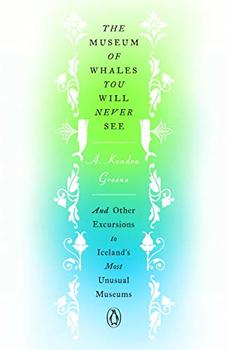Summary | Excerpt | Reviews | Beyond the Book | Read-Alikes | Genres & Themes | Author Bio
And Other Excursions to Iceland's Most Unusual Museums

 Book Reviewed by:
Book Reviewed by:
Lisa Bintrim
Buy This Book
This article relates to The Museum of Whales You Will Never See
.jpg) As A. Kendra Greene writes in The Museum of Whales You Will Never See, "Everywhere in Iceland is some kind of remote. It is almost always a word I reach for when describing a place here, though I mean it differently every time." Greene makes it clear that understanding Iceland requires understanding its geography, which affects not only where people live but how they live and how they see themselves.
As A. Kendra Greene writes in The Museum of Whales You Will Never See, "Everywhere in Iceland is some kind of remote. It is almost always a word I reach for when describing a place here, though I mean it differently every time." Greene makes it clear that understanding Iceland requires understanding its geography, which affects not only where people live but how they live and how they see themselves.
Iceland sits in the Atlantic Ocean, between Greenland and the United Kingdom. About the size of Kentucky, it has around 3,100 miles of ragged coast, pocked by long, deep fjords and bays. Largely formed of plateaux interspersed with mountain peaks, volcanoes and ice fields, the majority of the country—about 80 percent, including most of the center and much of the southern coast—is uninhabited. Most Icelanders live along the coast, particularly in the southwest; up to 20 percent of the population relies on fisheries and related industries, the second largest economic sector, behind tourism, for income. Even along the coast, however, many inhabited areas were not linked together by a paved road until recently. While Iceland consists primarily of one main island, it includes many smaller islands as well, some of which are home to a small portion of the population.
At around 20 million years old, Iceland is one of the world's youngest landmasses. It is made up of hundreds of volcanoes, including some of the world's most active. One of the most notable volcanic events in recent history was the series of eruptions at Eyjafjallajökull in 2010; ash disrupted air travel across Europe for a week. Even when the volcanoes aren't erupting, they are omnipresent in the geysers, black sand beaches and steaming lava fields found throughout the island. Iceland has harnessed its geothermal energy to produce about 25 percent of its electricity needs, including heat and hot water for much of the population. While the country was once around a quarter covered in woodland, today, Greene notes, "[There are] no trees...There is scrub and fog and midges and lava cooled into whorls like the grooves of massive fingerprints." Nearly all of the forests were lost to Viking settlers who cut down trees and burned scrubland to make fields and grazing land.
Iceland's geography has promoted a strong sense of national identity. In his article "Pingvellir: An Icelandic 'Lieu de Memoire,'" Gudmundur Halfdanarson argues, "In the heart of an Icelander, all of its nature is interwoven with an eventful history, and the mind wanders to encounter the people who once inhabited the country, struggling century after century towards an uncertain future. This people never gave up, never forgot their language, their stories, their memories." Brandon Boileau notes in "Iceland: Diverging Worlds, Emerging Identity," that for the country, "geographical isolation [has] resulted in a weak sense of belonging with either the historically rich European or progressive North American continents, thus fostering a strong ethnic and nationalistic identity."
Museums in Iceland play an important role in both recording and fostering this identity. From the colorful stones easily found among the lava to the artifacts of Icelander emigrants to North Dakota who "[left] a mostly treeless place and then [found themselves] in a forest" to boom towns abandoned when the tides shifted in the fishing industry, Greene demonstrates how Iceland's geography shapes what its people collect and the stories they attach to those collections, revealing in their own way who they are.
Map of Iceland showing Eyjafjallajökull volcanic site, courtesy of FreeWorldMaps.net
Filed under Places, Cultures & Identities
![]() This article relates to The Museum of Whales You Will Never See.
It first ran in the June 3, 2020
issue of BookBrowse Recommends.
This article relates to The Museum of Whales You Will Never See.
It first ran in the June 3, 2020
issue of BookBrowse Recommends.





The Flower Sisters
by Michelle Collins Anderson
From the new Fannie Flagg of the Ozarks, a richly-woven story of family, forgiveness, and reinvention.

The House on Biscayne Bay
by Chanel Cleeton
As death stalks a gothic mansion in Miami, the lives of two women intertwine as the past and present collide.

The Funeral Cryer by Wenyan Lu
Debut novelist Wenyan Lu brings us this witty yet profound story about one woman's midlife reawakening in contemporary rural China.
Your guide toexceptional books
BookBrowse seeks out and recommends the best in contemporary fiction and nonfiction—books that not only engage and entertain but also deepen our understanding of ourselves and the world around us.